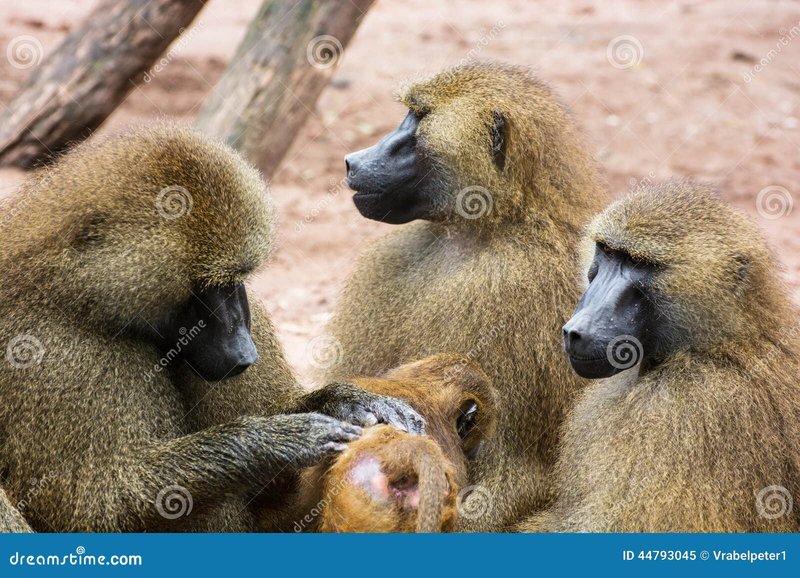
In the heart of Africa, Guinea baboons create a vibrant world for their young, filled with the challenges and adventures typical of the wild. Understanding how these animals protect and nurture their offspring can give us insight into their behavior and social bonds. So, let’s dive into their world and explore the delightful chaos of baboon parenting!
The Social Structure of Guinea Baboons
Guinea baboons are highly social animals, and their troop dynamics are crucial when it comes to raising young. Troops can range from a few individuals to over a hundred, and this social structure offers protection and support for the young ones. Each troop has a hierarchy, with dominant males and females, and this structure plays a significant role in child-rearing.
In a baboon troop, you might notice behaviors that seem almost human-like. For instance, older baboons often help care for younger ones. They share the duties of babysitting, allowing mothers to forage for food while knowing their young are in safe hands. This communal approach means that even if a mother needs to leave her infant for a bit, there will always be someone willing to step in.
You might be wondering, how does this hierarchy affect the young? Dominant females often have priority access to food and resources, which can lead to healthier offspring. The competitiveness among females can also create a pressure cooker environment, where the best mothers tend to raise the strongest young. This promotes a survival of the fittest vibe, ensuring that the best genes are passed down.
Maternal Care in Guinea Baboons
Mothers are the primary caregivers of the young baboons, and their bond is incredibly strong. When a baby is born, it clings to its mother’s belly, relying on her for warmth, protection, and nutrition. This close contact fosters a deep emotional connection. Honestly, watching a mother groom her baby is touching. Grooming serves a dual purpose: it strengthens their bond and ensures the little one is clean and free from parasites.
Mothers are fiercely protective of their young. If a perceived threat approaches, you’ll see them quickly scooping up their baby and either fleeing or standing guard. This instinctive behavior resembles how we might rush to protect our own children from danger. It’s crucial because young baboons are vulnerable, needing their mother’s guidance and protection to survive in the wild.
As the babies grow, mothers begin to encourage independence. They might let a young one venture a bit further as it learns to explore its surroundings. This is a delicate balance of nurturing and teaching self-reliance—something every parent can relate to. Those early experiences help young baboons develop social skills they’ll need later in life.
Social Learning Among Young Baboons
One of the fascinating aspects of Guinea baboons is how they learn from each other. Young baboons are keen observers, watching their peers and older troop members closely. They pick up essential life skills by mimicking others, whether it’s foraging for food or finding safe spots to play.
Let me explain this a bit further. Picture a young baboon watching its mother cracking nuts open. After observing the process, it might try its hand at the same task. This form of social learning is vital; it ensures that knowledge is passed down through generations. Youngsters learn how to survive, and their play often mimics survival skills. They practice chasing each other, which sharpens their agility and builds social bonds.
You might compare this to how kids often mimic their parents or older siblings. Remember when you learned to ride a bike by watching someone else? In the baboon world, what starts as play can be the foundation for critical life skills. It’s a powerful blend of learning and social interaction.
Parenting Strategies: Individual and Collective Care
While mothers are the main caregivers, the concept of shared parenting is prevalent in baboon troops. Female baboons often take turns babysitting, which is beneficial for both the young and the mothers. This allows mothers to take breaks and replenish their energy, knowing their child is in good hands. It’s like a village raising a child, where each adult plays an integral role in nurturing the next generation.
This shared responsibility also helps reinforce social bonds within the troop. Imagine a scene where several females gather together, grooming and caring for the young ones under the watchful eyes of mothers who have stepped away briefly. This not only helps the mothers but also prepares the young baboons for social interactions with their peers.
Interestingly, some studies suggest that the more an individual participates in caring for others, the better they become at raising their own offspring later. It’s a reciprocal system that benefits everyone. When they grow up, those baboons who learned care and nurturance from their peers tend to exhibit those same qualities.
The Role of Fathers and Other Males
Now, you might be surprised to hear that the role of males in baboon families is not entirely hands-off. While they don’t care for young baboons as actively as females, male baboons still play an essential part in the social structure. They help to protect the troop from predators and rival males, which indirectly contributes to the safety of the young.
Additionally, males often engage in playful activities with the young. You might catch a male baboon playing a gentle game of chase with a rambunctious infant. This interaction helps young baboons learn about social hierarchies and appropriate behavior in their troop. Honestly, it’s heartwarming to see these playful exchanges happening in nature.
Males can also influence the troop dynamics indirectly. Dominant males may have better access to mates, and their offspring are often more robust and successful. Thus, while their direct involvement might be limited, the presence of strong, healthy males contributes to the overall well-being of the troop’s young.
The Importance of Play in Development
Playtime is essential for Guinea baboon youngsters. It’s not just for fun; it’s a critical aspect of their growth and learning. During play, young baboons engage in activities that mimic adult behaviors—like wrestling or chasing—which prepares them for the challenges of adult life.
Think of it as rehearsal for the big show. Through these playful interactions, they learn social rules, develop physical skills, and build relationships with others in their troop. You might see a group of young ones tumbling over each other, and while it looks chaotic, it’s all part of their essential development.
Moreover, play can be a tool for conflict resolution. If two young baboons have a squabble, they might quickly bounce back into play, teaching them how to navigate social situations calmly. This playful approach to conflict mirrors how we often encourage children to “play nice” and resolve their differences.
Raising young in the wild is an intricate dance filled with joy, challenges, and teamwork among Guinea baboons. From the strong maternal bonds to the playful nature of the troop, there’s so much to appreciate about their parenting style. It’s a beautiful example of how animals rely on community and cooperation to ensure their young thrive.
Guinea baboons teach us that parenting—whether human or animal—is far more than just a solo act. It involves nurturing, guidance, learning, and a whole lot of play. Watching these social animals grow up in a supportive environment reminds us of the importance of community in our lives. As we reflect on baboon families, we can appreciate the shared journey of raising the next generation, one playful jump at a time.

